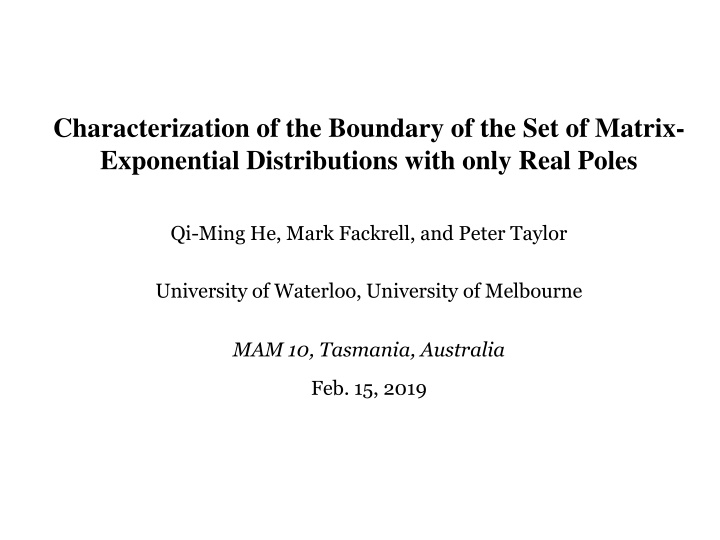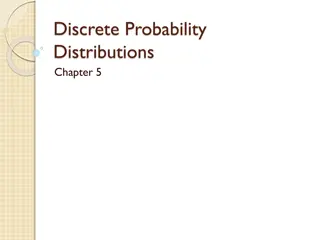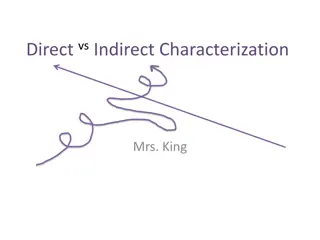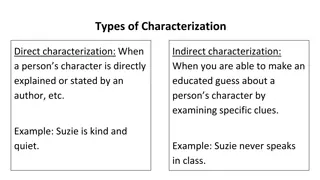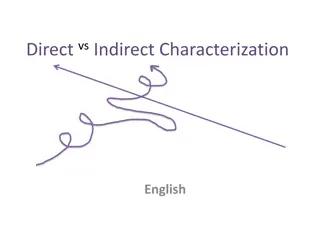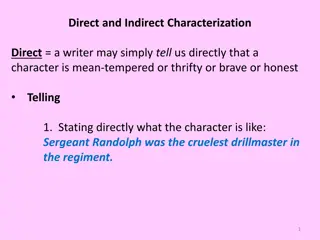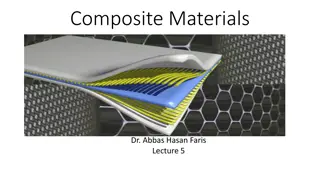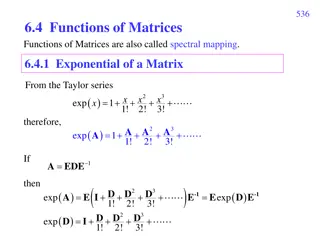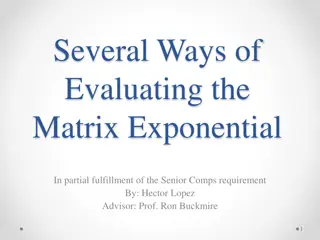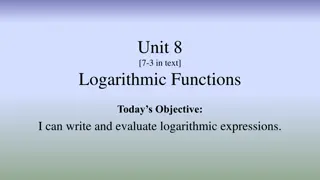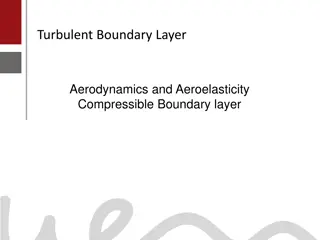Boundary Characterization of Matrix-Exponential Distributions
The boundary characterization of the set of matrix-exponential distributions with real poles. Understand the representation of ME random variables, their Laplace-Stieltjes transform, and the detailed characterization of the boundary based on distinct real numbers.
Download Presentation

Please find below an Image/Link to download the presentation.
The content on the website is provided AS IS for your information and personal use only. It may not be sold, licensed, or shared on other websites without obtaining consent from the author.If you encounter any issues during the download, it is possible that the publisher has removed the file from their server.
You are allowed to download the files provided on this website for personal or commercial use, subject to the condition that they are used lawfully. All files are the property of their respective owners.
The content on the website is provided AS IS for your information and personal use only. It may not be sold, licensed, or shared on other websites without obtaining consent from the author.
E N D
Presentation Transcript
Characterization of the Boundary of the Set of Matrix- Exponential Distributions with only Real Poles Qi-Ming He, Mark Fackrell, and Peter Taylor University of Waterloo, University of Melbourne MAM 10, Tasmania, Australia Feb. 15, 2019
Outline 1. Introduction 2. Problem of Interest 3. Examples and Intuition: 1, 2, 3, and 4 4. The General Case m 5. Discussion 2
1. Introduction A nonnegative random variable X has an ME-distribution if its probability distribution function has the form: = if 0. t 0, = = + ( ) { } F t P X t 1 1 exp( ) , if v 0, Tt T t where is a 1 m row vector, T is an m m matrix, and v is an m 1 column vector. The 3-tuple { , T, v} is called an ME- representation of the ME random variable X. The elements of { , T, v} can be real or complex numbers, as long as F(t) is a probability distribution function. Without loss of generality, we assume 0 = 0. ME-distributions were introduced in Asmussen and Bladt (1996). 3
1. Introduction (continued) The LST of X is given by a s s b s + + + + 1 2 m m a s a s a s + a ( ) ( ) = = ( ) 1 2 1 m m + + + 1 m m s b s b s b 2 1 m Given (s), an ME-representation can be obtained as { , T, v}, where = (a1, a2, , am) = a, v= (0, 0, , 0, 1) = em, and 0 1 0 1 = T 0 1 0 b 1 b b b b 1 2 2 1 m m m The pole(s) of (s) or the zero(s) of b(s) of the maximum real part is real and negative. 4
1. Introduction (continued) Definition Given b(s), define m the set of all vectors a = (a1, a2, , am) such that (s) = a(s)/b(s) defined in the above equationis the LST of a density function. Proposition (Bean, Fackrell, and Taylor (2008)) The set m is nonempty; contained in the upper half-space am 0; closed; bounded; and convex. They also characterized 3, the boundary of 3, is completely. 5
2. Problem of Interest Let { 1, 2, , m} be distinct real numbers and the zeros of b(s) (or the poles of (s) = a(s)/b(s)). Given the poles, we want a detailed characterization of m, the boundary of m. That is: we want to find a = (a1, a2, , am) in m. Comments: All a in the interior of m correspond to a phase-type distribution. The PH-order of those phase-type distributions goes from 1 to infinity. Some distributions in m are not phase-type, since their density function is zero at some x > 0 (i.e., f(x) = 0). 6
2. Problem of Interest (continued) Given 1 > 2> > m > 0, Let Fi(t) and fi(t) be the distribution and density functions of the exponential random variable Xi with parameter i, respectively, for i = 1, 2, .., m. Define = + + 12... Y X X X 1 2 m m m m = ( ) t ( ), for 0; i 12... F F t t m k = = i k 1 k 1, i i k m m = ( ) t ( ), for 0; i 12... f f t t m k = = i k 1 k 1, i i k + = ( ) s 1 2 m 12... m + + ( )( ) ( ) s s s 1 2 m 7
2. Problem of Interest (continued) Rewrite (s) as ... ( ) ( ) b s x x x a s = = + + + ( ) s ... 1 m m + 1 + 2 1 2 )( + + + ( ) ( )...( ) s s s s s 1 1 2 1 m with x1+x2+ +xm = 1, which is equivalent to = + ( ) .... t + + ( ) ( ) ( ) t f t 1 1 x f t 2 12 x f x f 123... m m We want to find all x = (x1, x2, , xm) such that f(t) is a density function, which is equivalent to identify m and m. We shall use the same notation. 8
3. Examples and Intuition m = 1: (s) = a(s)/(s+ 1) = 1/(s+ 1) X has to be exponential with parameter 1, with X1 and f1(t). 1 has only one element. m = 2: (s) = a(s)/(s+ 1)(s+ 2) = p 1/(s+ 1) + (1 p) 1 2/(s+ 1)(s+ 2) X has to be the convex sum of exponential X1 and X1+X2 (i.e., a generalized Erlang distribution, f12(t)): pf1(t) + (1 p)f12(t)). 2 contains (only) a line segment with two ending points X1 and X1+X2. (p < 0 or p > 1?) (Note: 1 > 2) That is: 2 = {f1(.), f12(.)}. 9
3. Examples and Intuition (continued) m = 3: (s) = a(s)/(s+ 1)(s+ 2)(s+ 3) X has to be the affine sum of X1(i.e., f1(t)), X1+X2 (i.e., f12(t)), and X1+X2+X3 (i.e., f123(t)): p1 f1(t) + (1 p1 p2)f12(t) + p2f123(t) 3 contains a triangle with three vertices X1, X1+X2, and X1+X2+X3. 3 looks like an ice-cream cone (Dohen and Latouche (1982)) 10
3. Examples and Intuition (continued) m = 3: (s) = a(s)/(s+ 1)(s+ 2)(s+ 3) The curved part connecting f1(.) and f123(.) f(t) = 0 and f (t) = 0 for some t > 0 (to find corresponding p1 and p2) Thus, the curved part can be obtained by solving the above system for t = 0 to . For t 0, f(.) f1(.); For t , f(.) f123(.); In summary, 3 = conv{f1(.), f12(.)} conv{f12(.), f123(.)} c 3. (Dohen and Latouche (1982)) 11
3. Examples and Intuition (continued) m = 4: (s) = a(s)/(s+ 1)(s+ 2)(s+ 3)(s+ 4) 12
3. Examples and Intuition (continued) Four sides: 3{f1(.), f12(.), f123(.)}; 3{f1(.), f12(.), f1234(.)}; 3{f1(.), f123(.), f1234(.)}; 3{f12(.), f123(.), f1234(.)}; ABC: One side; ABD: One side BCD: Two sides; ACD: Two sides 13
3. Examples and Intuition (continued) Thus, 4 consists of ice-cream cone 3{f1(.), f12(.), f123(.)} (including ABC) 1. ice-cream cone 3{f12(.), f123(.), f1234(.)} (including ABD) and 2. 3. a curved part (the green surface) 14
3. Examples and Intuition (continued) Find the curved part of 4: For t > 0, we use f(t) = 0 and f (t) = 0 to find the curved part of the boundary. For each t > 0, we find one solution g1,t(.) in c 3{f1(.), f12(.), f123(.)} and g2,t(.) in c 3{f12(.), f123(.), f1234(.)}. The curved part of 4 is: t>0 conh{g1,t(.), g2,t(.)}, where g1,t(.) c 3{f1(.), f12(.), f123(.)} and g2,t(.) c 3{f12(.), f123(.), f1234(.)} 15
4. General Case m m: (s) = a(s)/(s+ 1)(s+ 2)(s+ 3)(s+ 4)...(s+ m) f(t) = x1f1(t) + . + xmf12 m(t) Assume that 1 > 2> > m. m is between affine spaces 1 and 2: m k m = 1; x = 1; x k k = 1 = 1 k x 1 2 m = 0, = 0. x m k k = 1 k (for m-1) (for m-1 with f12(.), f123(.), , f12 m(.)) 16
4. General Case m(continued) If m > 3, m consists of three part: 1. m 1 (= 1 m), 2. 2 m, and 3. A curved part c m. 2 m: Generated by f12(.), f123(.), , f12 m(.), which can be characterized similar to m-1. 17
4. General Case m(continued) The curved part c m We define k{3} as k{3}= ice-cream cone {f1 k(.), f1 k(k+1)(.), f1 k(k+1)(k+2)(.)} for k= 1, 2, , m 2. For t > 0, we solve f(t) = f (t) = 0 to find a solution gt,k(.) in k{3} for k= 1, 2, , m 2. The solution is apparently in the curved part of k{3}, that is: gt,k(.) c k{3}. Then all solutions in conv{gt,k(.), k= 1, 2, , m 2} satisfying f(t) = f (t) = 0, which should be in the curved part of m. Then the curved part can be expressed as Ut>0conv{gt,k(.): gt,k(.) c k{3}. k= 1, 2, , m 2}. 18
4. General Case m(continued) Then m consists of m 1, 2 m, and Ut>0conv{gc,t,k(.): gc,t,k(.) c k{3}. k= 1, 2, , m-2}. 19
5. Discussion We still need to give rigorous mathematical proofs. Details on 2 m. Cases with complex poles (might be similar?) What are the potential applications? To check whether or not a = (a1, a2, , am) represents a probability distribution. 20
Thank you very much! Any question? Dehon, M.; Latouche, G. A geometric interpretation of the relations between the exponential and generalized Erlang distributions. Advances in Applied Probability. 1982, 14, 885-897. Fackrell, M. Characterization of Matrix-exponential Distributions. PhD thesis, School of Applied Mathematics, University of Adelaide, South Australia, 2003. Bean, N.; Fackrell, M.; Taylor, P. Characterization of matrix- exponential distributions. Stochastic Models, 2008, Vol 24 (3), 339-363.
3. Examples and Intuition (continued) m = 3: (s) = a(s)/(s+ 1)(s+ 2)(s+ 3) The curved portion of the ice-cream cone: For any f(.) on the curve, there exists (at least one) t > 0 such that f(t) = 0. The curve is generated by letting t to go from 0 to infinity. (An explicit formula is given in Dohen and Latouche (1982)) 22
3. Examples and Intuition (continued) m = 3: (s) = a(s)/(s+ 1)(s+ 2)(s+ 3) Edges: 1. p f1(t) + (1 p)f12(t): Not expandable (i.e., 0 p 1) 2. pf1(t) + (1 p) f123(t): Not expandable (i.e., 0 p 1) 3. (1 p)f12(t) + pf123(t): Not expandable (i.e., 0 p 1) Sides: 1. [f1(t), f12(t)]: The half plane contains f123(t) 2. [f12(t), f123(t)]: The half plane contains f1(t) 3. [f1(t), f123(t)]: Both sides contain ME-distributions The curved part connecting f1(t) and f123(t) 23
3. Examples and Intuition (continued) So, to find a solution f(.) in the curved part of 4, the two equations f(t) = 0 and f (t) = 0 for some t > 0 is not enough to find f(.) directly. The idea is to find one solution in c 3{f1(.), f12(.), f123(.)} and one in c 3{f12(.), f123(.), f1234(.)}. Then f(.) is in the convex hull of the two solutions. This is the basic idea for finding the curved part of m of m > 4. 25
